In today’s hyper-connected advertising realm, businesses need to embrace online advertising to reach their audience effectively. Programmatic advertising has emerged as a powerhouse in the world of online marketing, offering a sophisticated and automated approach to connect advertisers with their target audience. But how does programmatic advertising actually work, and who are the key players in this dynamic ecosystem?
What is programmatic advertising?
At its core, programmatic advertising is a seamless, automated exchange of ad inventory in real-time, all thanks to the wizardry of sophisticated algorithms. It’s a digital maestro that draws upon an extensive tapestry of data, from user demographics and behaviors to contextual cues. This intricate dance of information analysis crafts the stage for the delivery of highly targeted and personalized advertisements, spreading across a multitude of platforms and channels.
So, how does this intricate web of programmatic advertising come to life?
In the sections ahead, we’ll peel back the layers, revealing the key actors, tools, and mechanisms that orchestrate this high-tech symphony.
At the heart of programmatic advertising lies an ensemble of key players and the tools that facilitate this digital choreography. To grasp the inner workings of programmatic, it’s vital to acquaint yourself with these integral components.

In essence, programmatic’s core objective is to seamlessly unite advertisers and publishers, bolstering their efficiency in reaching their respective objectives.
Advertisers: This category encompasses brands, agencies, or individuals with a vested interest in promoting their products or services through programmatic advertising. They come equipped with campaign goals, target audiences, channel preferences, and creative assets, all poised to be employed in the quest for audience engagement.
Publishers: These are the gatekeepers of digital real estate, owners of websites, mobile apps, and digital platforms where advertisements find their virtual stage. Publishers offer their ad inventory for programmatic acquisition, making it accessible to advertisers hungry for a slice of the digital spotlight.
The Conduit of Connection: Programmatic Platforms
To facilitate this intricate exchange of digital real estate and ad impressions, advertisers and publishers employ programmatic platforms, namely Demand-Side Platforms (DSPs) and Supply-Side Platforms (SSPs). These platforms serve as the conduits of connection, streamlining the buying and selling of digital media.
Demand-side platforms
Demand-Side Platforms, or DSPs, stand as the linchpin of programmatic advertising from the buying perspective. They empower advertisers to wield a plethora of tools and tactics in their quest for ad impressions across digital landscapes.
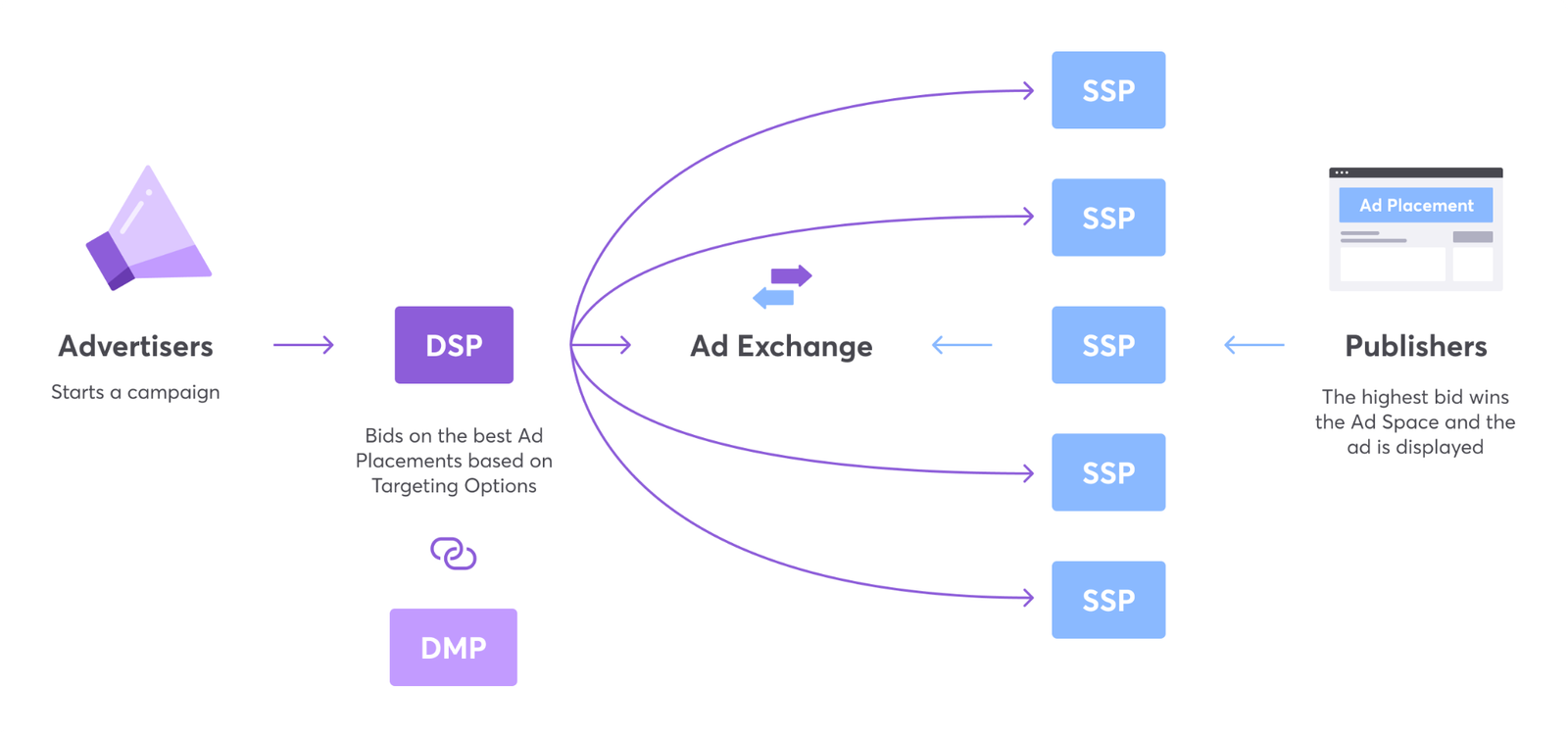
The DSP Advantage: Advertisers, when equipped with DSPs, enjoy the following key advantages:
- Robust Targeting Capabilities: DSPs allow advertisers to fine-tune their campaigns with an array of targeting parameters. From demographics to interests, they can zero in on their ideal audience.
- Budget Management: Advertisers can meticulously manage their budgets within the confines of DSPs, ensuring efficient allocation of resources.
- Bidding in Real-Time: The bidding process unfolds in real-time across multiple ad exchanges, enabling advertisers to seize the most favorable ad impressions.
- Efficiency Optimization: DSPs streamline the entire negotiation process between advertisers and publishers. Automation is the driving force, enhancing efficiency and eliminating manual hurdles.
- Comprehensive Inventory Access: These platforms provide access to a broad spectrum of ad inventory, affording advertisers the opportunity to explore a diverse range of placements.
- Centralized Performance Insights: With DSPs, advertisers can conveniently assess their campaign performance through centralized dashboards, providing valuable insights and data-driven decision-making.
In the intricate dance of programmatic advertising, DSPs choreograph the moves, ensuring that every step taken is precise and cost-effective.
Supply-side platforms
Supply-side platforms, or SSPs, are the virtuoso conductors of the programmatic orchestra, expertly managing publishers’ ad inventory and harmonizing revenue generation. These platforms are the guardian angels of publishers, ensuring that their available ad slots receive the attention they deserve.
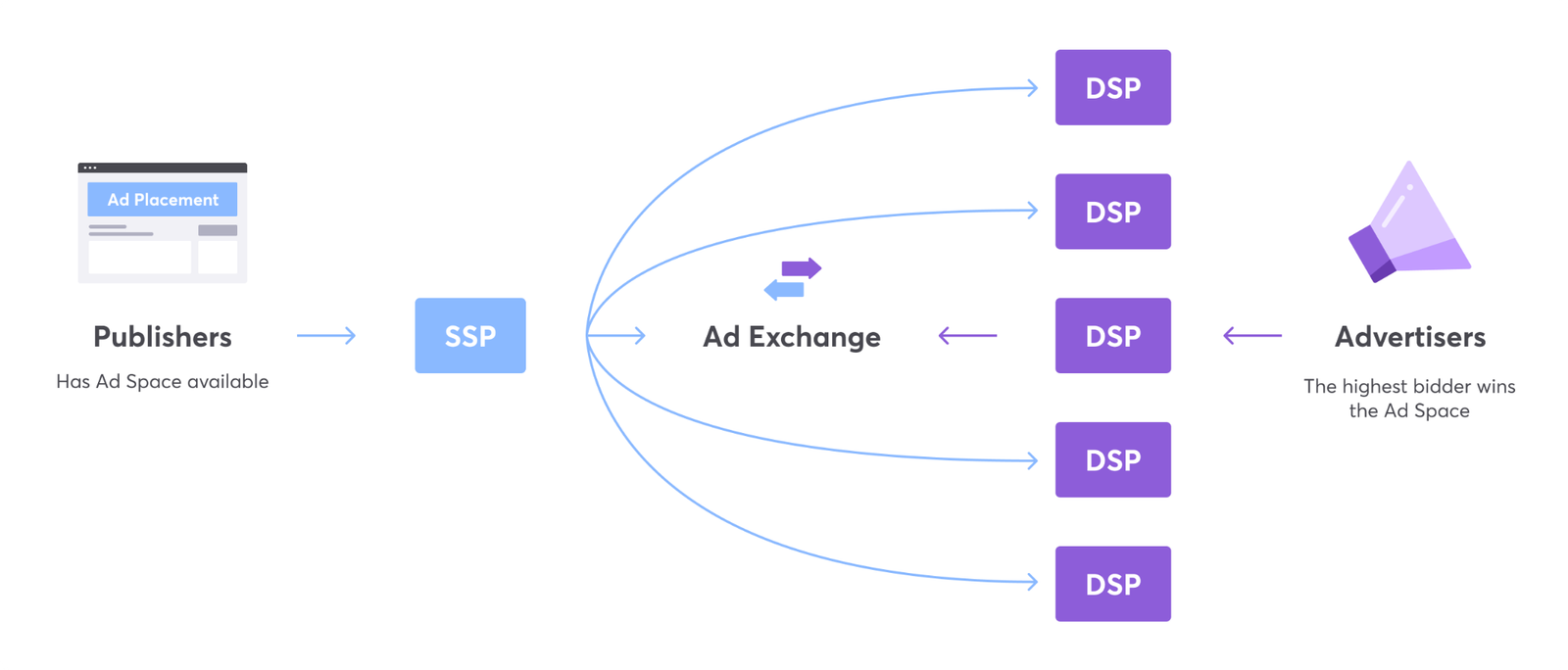
The SSP Melody: Here are some key advantages that SSPs bring to the forefront:
- Automated Ad Sales: SSPs automate the process of selling ad slots for publishers, reducing manual workload and maximizing efficiency.
- Broad Network Connectivity: Publishers leverage SSPs to connect with various ad networks, broadening their horizons and increasing the chances of filling more ad slots.
- Effective Inventory Management: SSPs enable publishers to manage their inventory efficiently, ensuring a steady flow of ad placements while maintaining control over pricing and availability.
- Frequency Capping: Publishers can prevent overexposure to the same ad by implementing frequency capping. This strategy ensures that a specific or similar ad is not overly shown to the same visitor.
- Revenue Maximization: By auctioning their available ad slots through SSPs, publishers can optimize revenue generation while maintaining flexibility in their ad offerings.
In the grandeur of programmatic advertising, SSPs stand as pillars of strength, empowering publishers to derive the most value from their ad spaces, all while orchestrating an elegant performance for their audiences.
Data management platforms
In the symphony of programmatic advertising, Data Management Platforms (DMPs) play the role of maestros, orchestrating the harmonious fusion of data, insights, and personalized ad experiences. They are the virtuoso conductors behind the scenes, shaping the melody of audience segmentation and relevance.
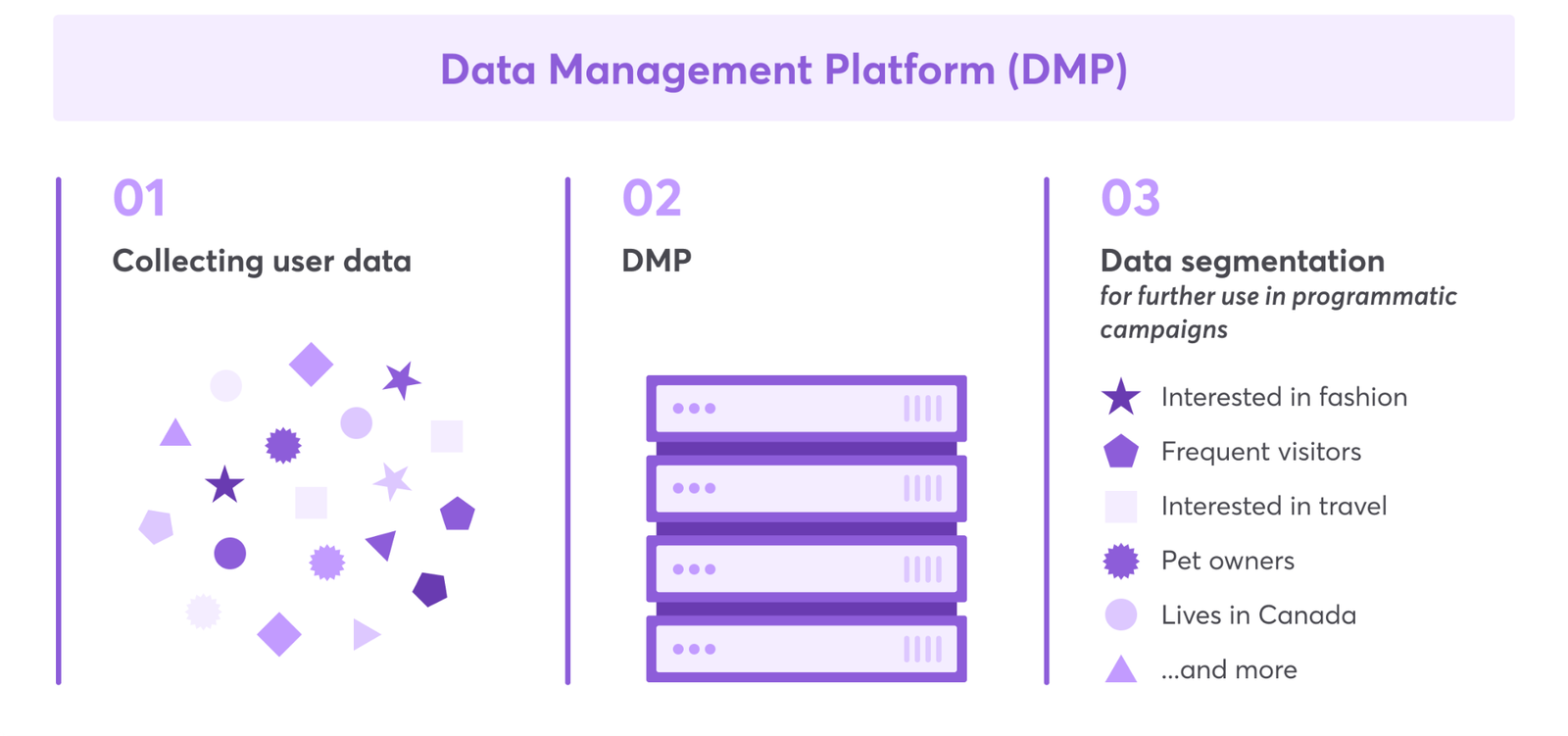
The DMP Overture: Here’s how DMPs create a masterful performance:
- Data Collection and Storage: DMPs collect data from diverse sources across the digital landscape, assembling a comprehensive repository of user information. This data includes demographics, online behavior, interests, and more.
- Data Analysis: DMPs dive into the sea of data, dissecting, and deciphering it to reveal invaluable insights. They construct user profiles and identify specific segments based on a multitude of parameters.
- Audience Segmentation: DMPs are the architects of audience segmentation. They enable advertisers and publishers to divide their audiences into distinct segments, each with its unique characteristics and preferences.
- Targeted Advertising: Armed with rich user profiles and segmented audiences, DMPs empower advertisers to serve highly relevant and personalized ads. Ad campaigns become laser-focused, ensuring that the right message reaches the right audience.
The DMP Crescendo: The orchestration of data by DMPs leads to informed decision-making, optimized advertising campaigns, and ultimately, superior results. DMPs act as the backbone of precision in programmatic advertising, crafting the magic of tailored ad experiences that captivate and convert.
In the realm of programmatic advertising, DMPs are the silent architects of resonance, shaping the digital symphony to deliver better outcomes and more meaningful connections.
Ad exchanges
Ad exchanges emerge as vibrant marketplaces, connecting advertisers and publishers in a dynamic dance of supply and demand. They are the bustling trading floors where ad impressions find their value, and where the heartbeats of real-time auctions resound.
The Ad Exchange Bazaar: Here’s a glimpse of the lively proceedings:
- Publishers Unveil Their Offerings: Publishers, akin to merchants, showcase their wares – in this case, ad slots within their digital domains. These ad slots, the digital billboards of the internet, become available for trade.
- Advertisers Enter the Arena: Advertisers, the astute buyers, enter the ad exchange arena with their strategies, budgets, and creative ammunition. They aim to secure ad slots that align with their campaign objectives and audience targets.
- Real-time Auctions Unfold: The magic happens as real-time auctions burst into action. Advertisers place bids on the available ad slots, vying to claim them for their ad campaigns. The highest bidder prevails, and their ad is destined for display.
- Balancing Supply and Demand: The ad exchanges strike a harmonious balance between supply and demand. Advertisers seek the best slots to reach their audiences, while publishers seek to monetize their digital real estate.
The Ad Exchange Symphony: Ad exchanges, powered by the dynamics of demand and supply, orchestrate a synchronized marketplace where the currency is ad impressions. It’s a marketplace that thrives on efficiency, transparency, and the pursuit of delivering the right message to the right audience.
In the grand performance of programmatic advertising, ad exchanges are the spirited conductors of transactions, ensuring that the digital stage is set for the most relevant and engaging ad experiences. They are where the art of the deal meets the science of data, creating a symphony of precision in the world of online advertising.
Ways to launch programmatic ad campaigns
programmatic emerges as a versatile landscape, offering advertisers a diverse array of avenues to embark on their campaigns. Unlike the unyielding confines of certain advertising channels, such as social media, programmatic provides a bouquet of choices, each catering to specific objectives and conditions. Choosing the right programmatic route is akin to selecting the ideal vehicle for a journey, and the road you take depends on several factors:
Just as different terrains demand various vehicles, your campaign goals dictate the programmatic approach. The level of control, targeting precision, and inventory accessibility vary between programmatic options. Whether your aim is to boost brand awareness, drive conversions, or attain specific KPIs, your choice should align with your destination.
Effective advertising is about reaching the right audience with the right message. Different programmatic types excel at targeting specific audience segments. Your choice hinges on your understanding of your audience and their behavior.
In the economic realm of programmatic, pricing varies across different avenues. The cost-effectiveness of options like Real-Time Bidding (RTB) may stand out, as it operates with fixed, negotiated prices. Assess your budget, bearing in mind external factors that may influence pricing fluctuations.
The level of control and transparency over ad inventory varies within the programmatic spectrum. Depending on your requirements for inventory quality and the degree of transparency you seek, you may opt for one programmatic type over another.
The scale and duration of your campaign influence the programmatic route you choose. Some programmatic deals are swift, streamlined, and apt for quick deployments, while others require deeper negotiations and planning. Assess your timeline and campaign scale for an informed decision.
By understanding these elements and weaving them into your decision-making process, you can chart a programmatic course tailored to your campaign’s unique needs. In the dynamic landscape of programmatic advertising, the route to success is as diverse as the advertisers themselves, offering a path for every objective, audience, and budget.
Open RTB
Open RTB shines as a popular beacon in the advertising landscape. So much so that it’s often colloquially used as a synonymous term for programmatic advertising itself. But what exactly is Open RTB, and how does it work?
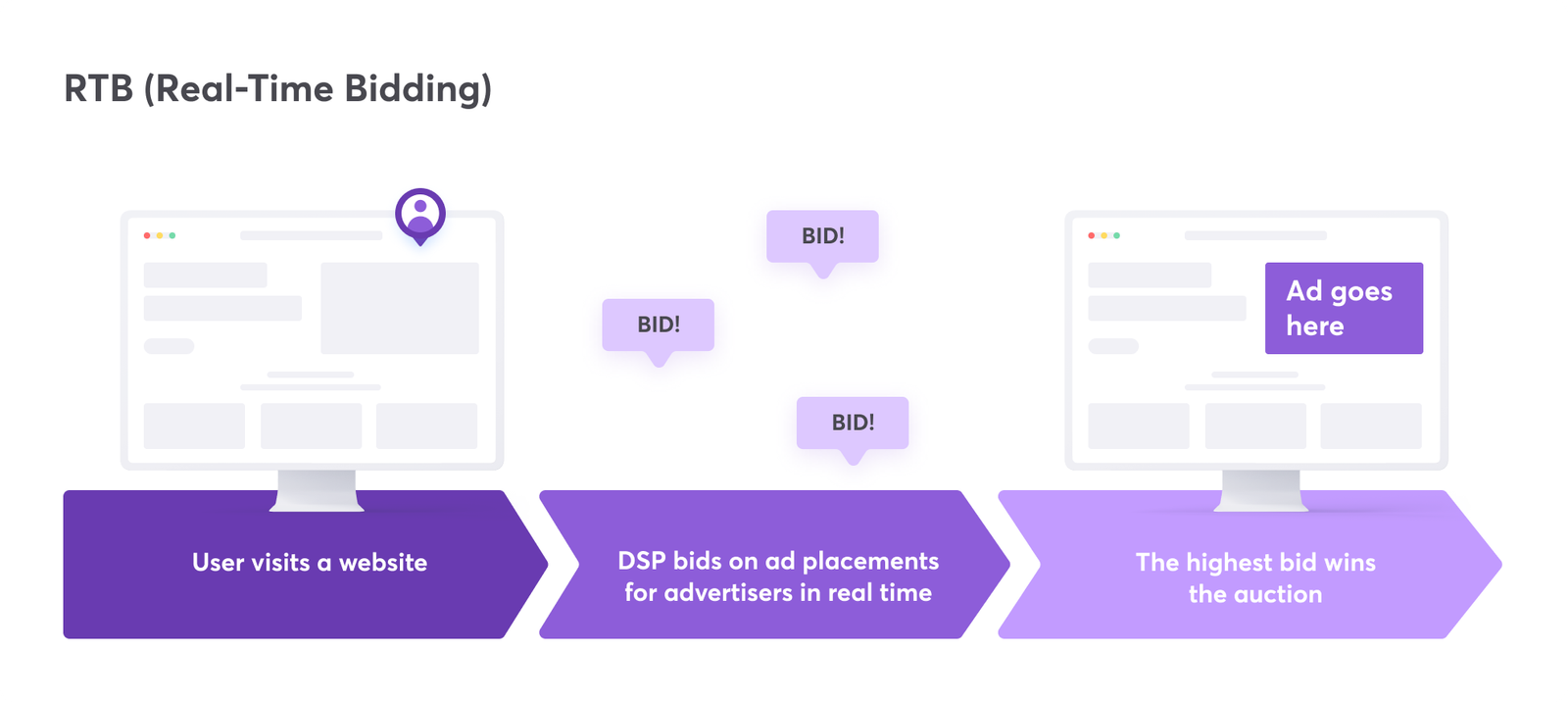
Open RTB, short for Real-Time Bidding, takes the stage as an auction-based programmatic advertising method. The name itself hints at its defining characteristic – it operates as an open marketplace accessible to the public. Here, advertisers and publishers engage in a competitive process for ad impressions.
In the realm of Open RTB, the final cost of an ad slot is the outcome of the digital demand ecosystem. As advertisers seek to secure ad placements on publisher websites, they submit their bids. In a vibrant and dynamic fashion, the highest bidder emerges victorious, and their ad graces the publisher’s digital realm.
Open RTB thrives on the principle of competition, providing a transparent platform where demand steers the course. This means that any advertiser and publisher can participate, fostering an environment where the market dictates the ad slot’s worth. The result is a fair, real-time digital marketplace that maximizes value for both parties.
The journey through Open RTB is akin to participating in a digital auction. Advertisers evaluate their campaign objectives, target audience, and ad creatives before venturing into the open marketplace. The process is defined by an intense but efficient competition where the highest bid secures the ad placement.
The open nature of Open RTB signifies that every participant has an equal opportunity to engage, ensuring fair competition and equitable results. This method harmonizes advertisers’ and publishers’ interests, emphasizing transparency and efficiency.
Private Marketplace (PMP)
Private Marketplace, or PMP, emerges as another dynamic method that thrives on an auction-based system. But how does it stand out from the crowd and what sets it apart from Open RTB?
Much like Open RTB, PMP operates within the framework of real-time bidding and an auction-style approach. Advertisers have the opportunity to engage in real-time bidding for ad impressions, with the highest bidder ultimately securing the coveted ad placement. Here’s where the distinction arises. Unlike the open-access nature of Open RTB, Private Marketplaces follow a different protocol. Access to PMPs is not universal but comes by way of exclusive invitations extended by publishers. These exclusive partnerships adhere to specific prerequisites, granting premium inventory access to selected partners.
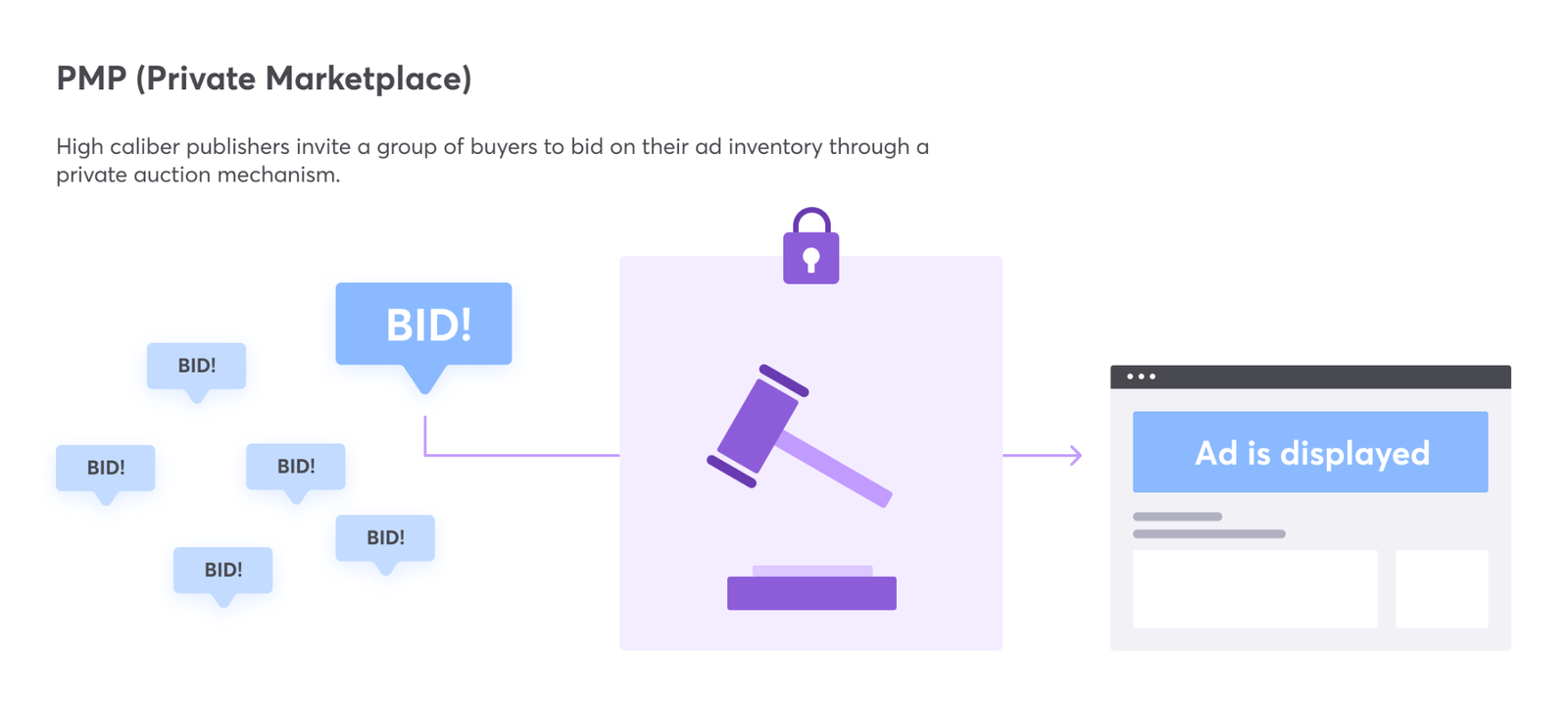
The journey through a PMP begins when publishers establish a floor price for their premium inventory. The bidding process kicks off once this floor price is set. Advertisers, equipped with a clear vision for their campaigns, can then compete for ad impressions in real-time, hoping to secure their place as the highest bidder.
The allure of PMP lies in its exclusivity. Publishers open their premium inventory to a select circle of partners, ensuring that the ad slots are presented to advertisers who meet defined criteria. This enhances the quality of ad placements and assures that brands engage with a more discerning and receptive audience.
Programmatic Guaranteed
This method distinguishes itself from the open auctions of Open RTB and the exclusive invitations of Private Marketplaces (PMP). Unlike the lively bidding process characterizing its programmatic counterparts, Programmatic Guaranteed takes a different route. It ushers advertisers and publishers into a negotiation-based scenario, eschewing the lively auction dynamics.
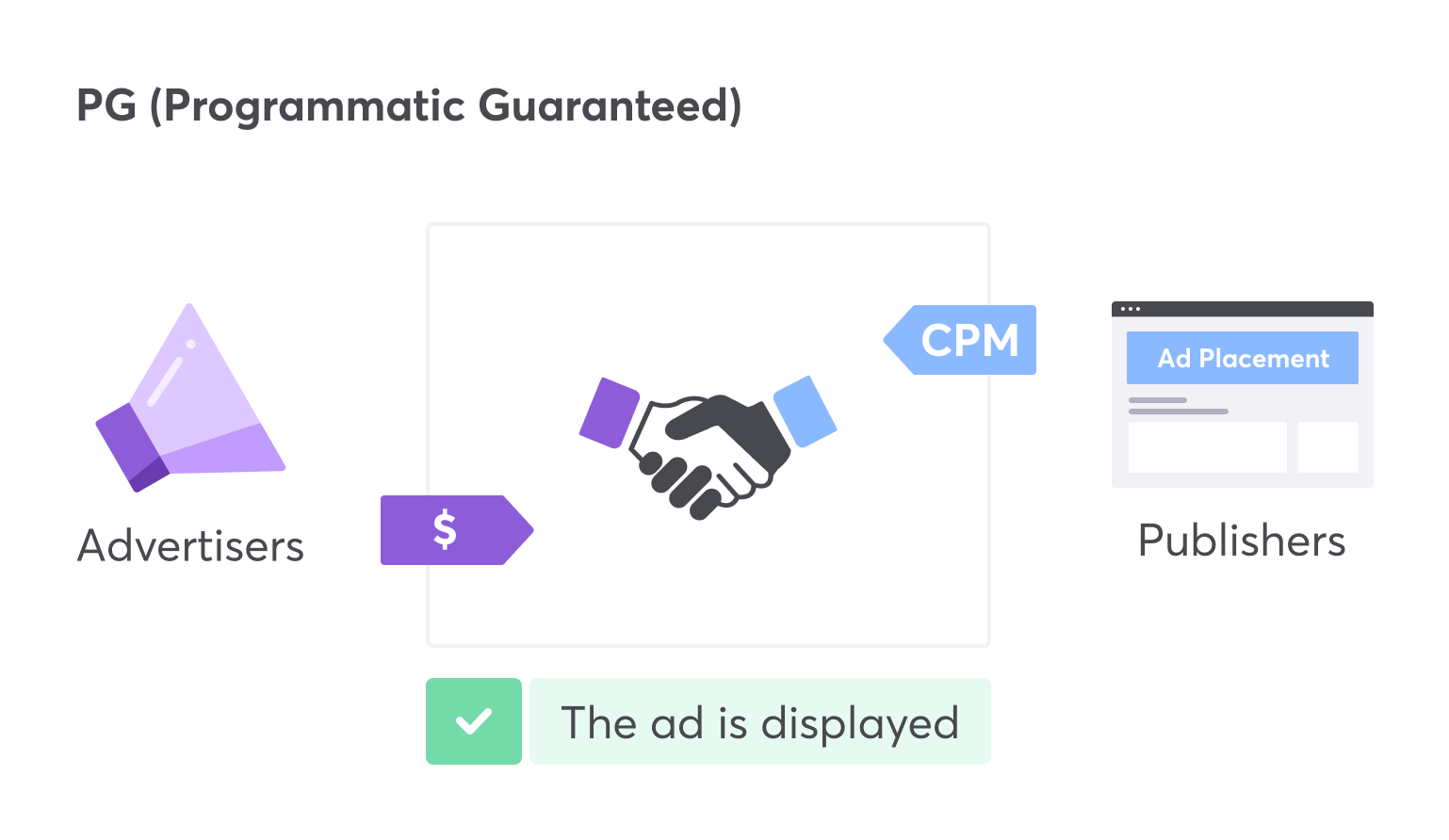
In this scenario, advertisers engage directly with publishers to establish a fixed price, typically measured as CPM (Cost Per Mille), for their desired ad placements. This negotiation phase extends to other crucial aspects of the ad campaign as well.
Once consensus is reached on the CPM rate and the required number of impressions, a critical shift occurs. The ad inventory is now exclusively designated for the agreed-upon buyer, and they are bound to make the purchase. This guarantees a reserved space in the publisher’s inventory.
While Programmatic Guaranteed mirrors the conventional practice of direct price negotiations between advertisers and publishers, it still retains its programmatic essence. Automation plays a pivotal role, significantly reducing manual involvement. This fusion of traditional practices with programmatic efficiency offers a compelling proposition for those seeking a balanced approach.
Preferred Deals
Much like Programmatic Guaranteed, this method involves direct negotiations between advertisers and publishers. However, Preferred Deals introduce a distinctive twist that sets them apart in this dynamic arena.
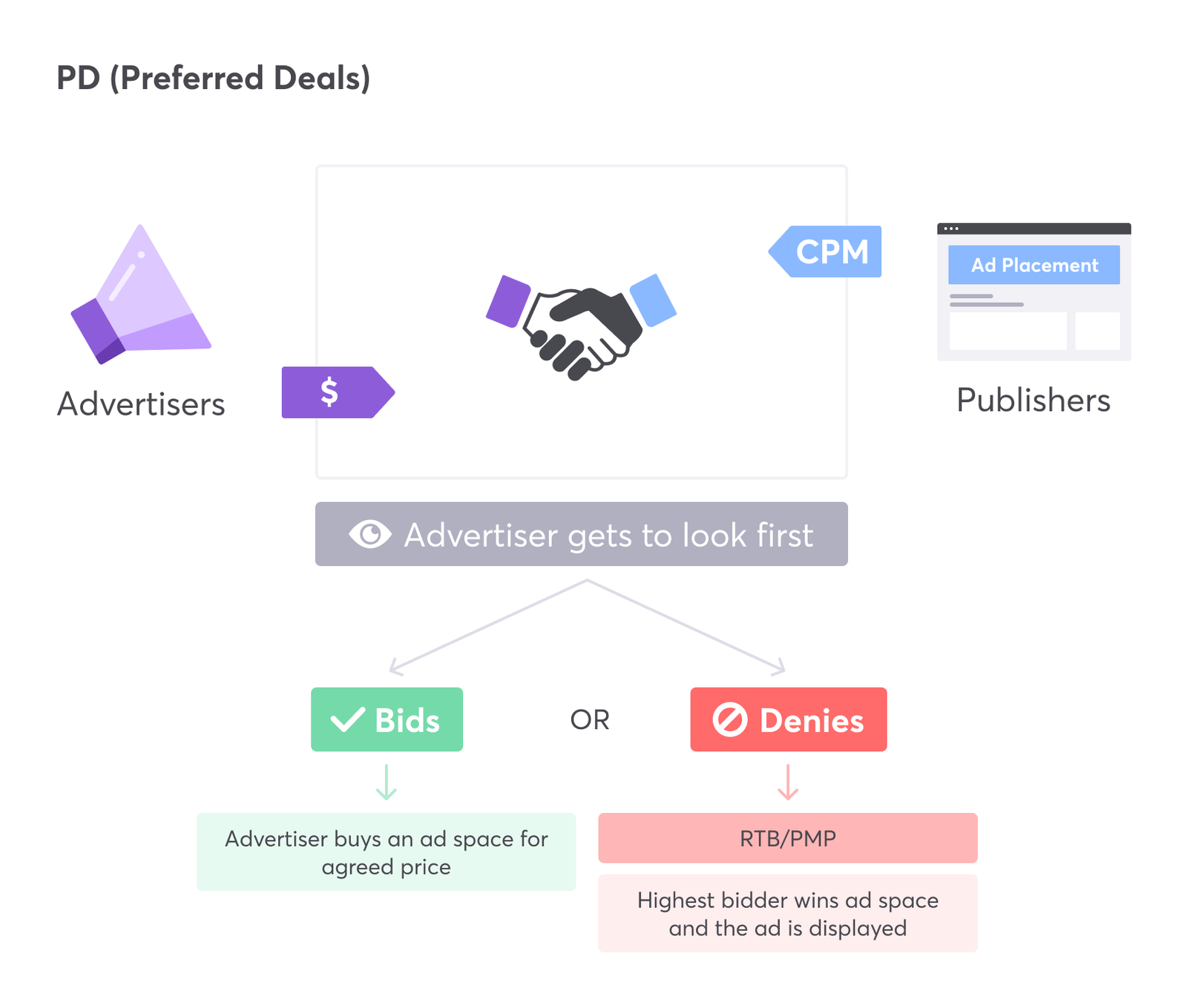
Similar to Programmatic Guaranteed, Preferred Deals necessitate the agreement on a fixed price for ad placements. Advertisers and publishers collaborate to set the terms, ensuring clarity in the arrangement. The hallmark of Preferred Deals lies in the priority they confer to advertisers. Before ad slots become available on Open RTB or Private Marketplaces (PMP), advertisers receive a “sneak peek.” This exclusive insight into ad slots grants them priority in bidding.
A defining feature of Preferred Deals is the freedom they afford advertisers. Unlike Programmatic Guaranteed, where advertisers commit to purchasing agreed-upon ad inventory, Preferred Deals offer flexibility. Advertisers can choose to deny the placement if it doesn’t align with their objectives.
Should advertisers opt not to proceed with the agreed placement, publishers can seamlessly pivot. They have the option to sell the ad slot through open or private auctions, ensuring that valuable inventory finds its purpose.
How ads get displayed?
Let’s delve into the key steps of launching a programmatic ad campaign within the boundaries of Open RTB, shedding light on the underlying mechanics.
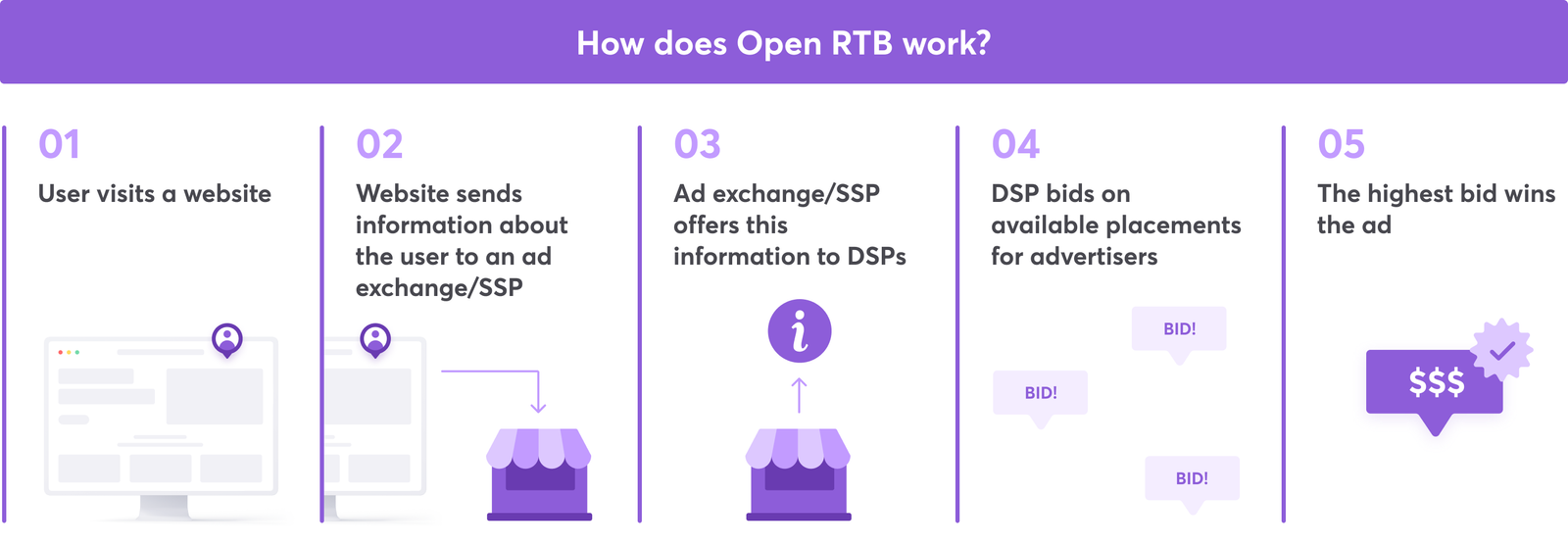
Step 1: User Activity and Data Collection The journey commences when a user visits a website or engages with digital content. This user-specific interaction is a pivotal starting point. Data associated with this user, encompassing demographics, behavior, and more, is systematically gathered. This wealth of user information finds its repository in a Data Management Platform (DMP), a guardian of user data.
Step 2: The Role of DSPs The DMP then collaborates with Demand-Side Platforms (DSPs), interconnecting this expansive reservoir of user data with the advertising world. The DMP sends this valuable information to ad exchanges or Supply-Side Platforms (SSPs), thereby introducing it into the programmatic landscape. The DSP acts as a bridge, seamlessly conveying user data to where it’s needed most.
Step 3: Publisher’s Contribution On the other side of the spectrum, publishers, who own websites, mobile apps, and digital platforms where ads are displayed, enter the narrative. They supply available ad placements to the programmatic ecosystem, eagerly anticipating the arrival of advertisers. Publishers, with their array of ad slots, fuel the programmatic process.
Step 4: The Auction Mechanism The real-time bidding phase is where the heart of programmatic advertising beats. Within this realm, DSPs come to life. Using pre-set criteria, they strategically bid on the ad placements in real time. It’s here that competition thrives, and ad impressions are auctioned to the highest bidder.
Step 5: The Ultimate Display In the final crescendo, the highest bid clinches the ad placement. The chosen ad is displayed, capturing the attention of users in the digital landscape. The user sees what the DSP, with its intricate algorithms, deemed to be the most relevant and engaging.
Publisher’s Perspective The publisher’s role is distinct but vital. They communicate with SSPs to list their available ad space within an ad exchange or directly with DSPs. In a parallel process, the publishers introduce their inventory into the realm of real-time bidding. The DSPs, on the lookout for prime ad slots, engage in a spirited contest to secure these slots for advertisers.
How are ad prices determined?
Assigning a fixed price to programmatic advertising can be challenging, as it hinges on a multitude of variables that can sway the cost. Some of these influencing factors encompass:
1. Demand and Supply Dynamics: The ebb and flow of supply and demand in the advertising ecosystem play a significant role. When the demand for ad inventory is high, as seen, for example, during the holiday season, competition among advertisers escalates, which can elevate ad costs.
2. Geographic Considerations: The geographic location of the publisher holds sway. Advertisers often find themselves paying more for ad placements in regions with higher demand and competition.
3. Seasonal Fluctuations: Timing can be pivotal. Certain times of the year, such as the lead-up to the holiday season, see an increased demand for advertising inventory, invariably leading to higher ad costs.
4. Inventory Quality: The quality and prominence of the ad inventory is another pivotal factor. Premium inventory often commands higher prices due to its coveted placement and visibility.
5. Targeting Precision: The level of precision in audience targeting is directly proportional to cost. The more specific an advertiser’s targeting criteria, the higher the associated price.
6. Advertising Channels: Different advertising channels, including display, video, connected TV (CTV), in-game, and more, come with distinct cost structures. Each channel’s unique attributes influence the pricing dynamics.
7. Visitor Devices: The device used by a visitor, whether it’s a mobile device, tablet, or desktop, can impact ad costs. It’s a facet advertisers consider when crafting their campaigns.
The commonly employed pricing metric is CPM, which stands for “Cost Per Mille” or cost per 1,000 ad impressions. On average, CPM rates typically fall within the range of $0.50 to $2, though these figures are contingent on the multifaceted interplay of the aforementioned factors. The intricate and dynamic nature of programmatic advertising necessitates a nuanced approach to pricing, with flexibility and adaptability being key to navigating the ever-changing landscape.
Is programmatic advertising effective?
In essence, the verdict is a resounding “yes” – programmatic advertising is indeed an effective and transformative approach to modern advertising.
The effectiveness of programmatic advertising can be attributed to several key factors:
1. Automation and Efficiency: Programmatic harnesses automated technology and advanced algorithms, which bestow advertisers with the ability to enhance campaign efficiency. This not only saves valuable time but also empowers advertisers to allocate their resources towards campaign optimization and fine-tuning, a vital aspect of achieving the best possible results.
2. Data-Driven Precision: Programmatic advertising is profoundly data-centric. It leverages a wealth of data, encompassing user behaviors, demographics, and a multitude of contextual factors. This rich data landscape underpins the delivery of highly targeted ads to specific audience segments. Unlike traditional advertising, which relies on assumptions, programmatic is founded on actual user behavior data, eliminating guesswork and leading to the creation of ads that are genuinely relevant and appealing to the audience. This, in turn, elevates the prospects of positive outcomes for brands.
3. Superior ROI: The precision and immediacy afforded by programmatic’s targeting capabilities, real-time optimization, and overall efficiency translate into a notable advantage in terms of return on investment (ROI). Programmatic often surpasses the ROI achieved through more conventional advertising methodologies. It delivers not only cost-effective solutions but also ensures that each advertising dollar is directed towards the right audience, which is instrumental in fostering a higher ROI.
It seamlessly combines automation, data-driven precision, and an impressive ROI, effectively streamlining the path to advertising success and positive brand outcomes. As the digital advertising realm continues to evolve, programmatic advertising remains an indispensable tool for marketers worldwide.
Anything else you want to know about programmatic?
The reassuring news is that advertisers and publishers need not navigate this complexity in isolation. There exists a wealth of dependable programmatic advertising platforms and expert companies that are well-equipped to offer their guidance, expertise, and invaluable support. Their knowledge and resources can expedite your journey toward realizing your advertising objectives.
Whether you’re just venturing into the realm of programmatic advertising or seeking a fresh perspective, we invite you to reach out and make a connection. Do not hesitate to contact our dedicated team at Nigel Quadros Digital, where we are ready to provide assistance, share insights, and guide you every step of the way.
Let us join forces and embark on the journey to launch your next programmatic advertising campaign. Together, we can explore the possibilities, harness the power of programmatic, and unlock the full potential of your advertising efforts.



Permalink